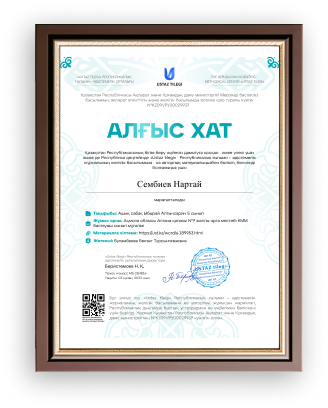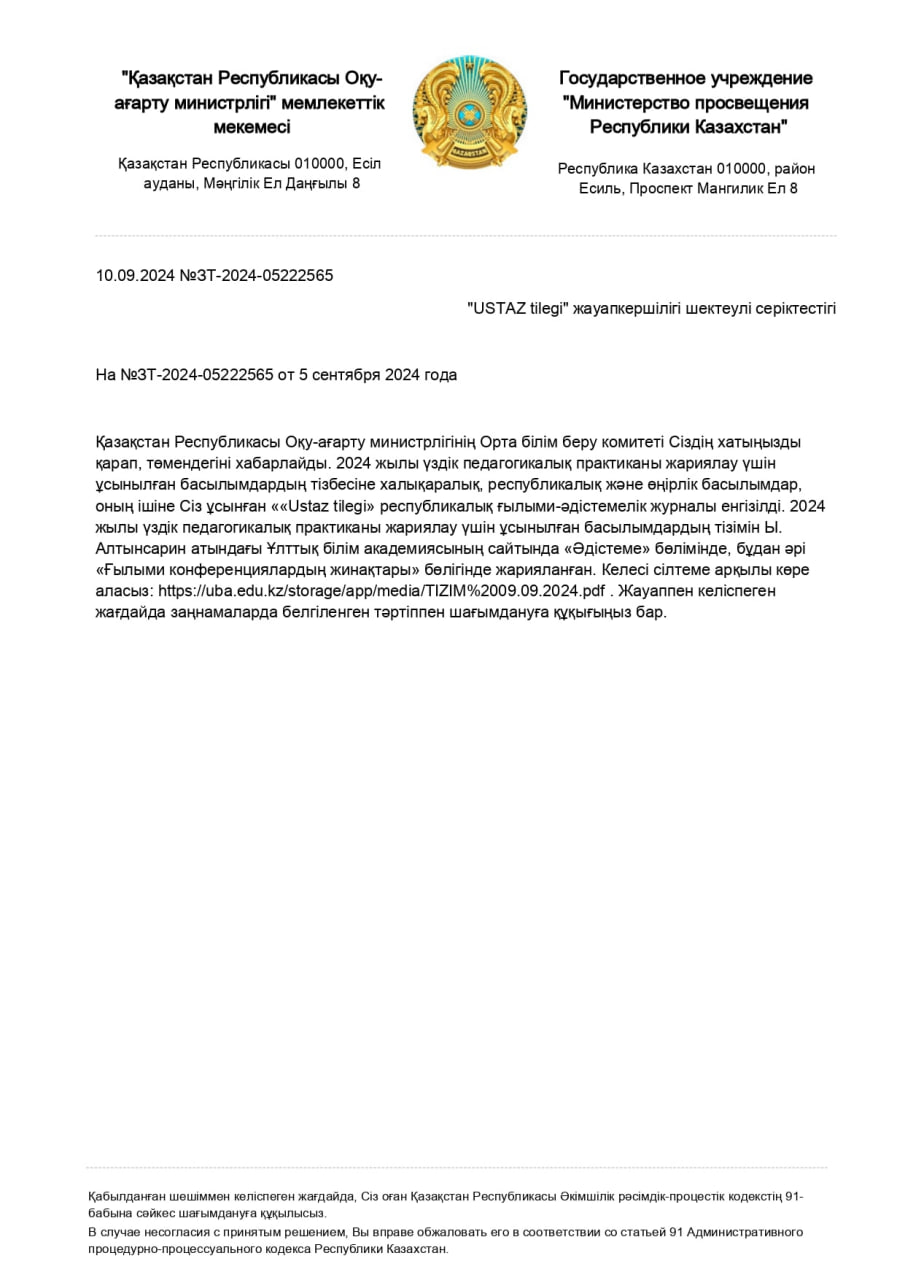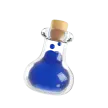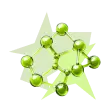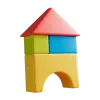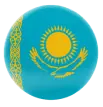|
LESSON: Module 8 Lesson
2
Reading short online
texts
|
School: school # 4named after Sagadat
Nurmagambetov
Oskemen city East Kazakhstan
Region
|
|
Date: 12 .04.
2024
|
Teacher
name: D. M.
Zhamanbalinova
|
|
CLASS: 8
a
|
Number
present: 12
|
absent:
|
|
Learning
objectives(s)
that this lesson
is
contributing
to
|
8.4.2.1
understand specific
information and detail in texts on a growing range of familiar
general and curricular topics, including some extended
texts;
8.4.5.1 deduce meaning from
context in short texts and some extended texts on a growing range
of familiar general and curricular
topics;
8.1.8.1
develop intercultural
awareness through reading and discussion
|
|
|
All learners will be able
to:
- get to know about dangerous
foods ,make reasoned guesses of the
meaning of new words, make up 4 simple
sentences about personal eating habits and foods which are
dangerous to eat with support
Most learners will be able
to:
-
understand understand specific
information and detail of the text; give the definitions of
new words, describe eating habits and dangerous foods at a sentence
level using descriptive adjectives with little
support
Some learners will be able
to:
- identify stated elements:
food features , useful and harmful foods , make up sentences with
new words, demonstrate the ability to describe eating habits and
dangerous foods at a discourse level without
support
|
|
Assessment
criteria
|
Learners have met the learning
objectives if they
- understand texts about
dangerous ,
-are able to explain the
meaning of new words and use them while describing
foods.
|
|
Value links
|
Solutions to healthy eating
and a healthy way of life
|
|
Cross - curricular
links
|
Biology
|
|
ICT skills
|
CD, video, interactive
board
|
|
Previous learning
|
Cooking
verbs
|
|
Plan
|
|
Planned timings
|
Planned
activities
assessment
|
Resources
|
|
Teacher
|
Students
|
assessment
|
|
Starter
1
min.
|
T. asks Ss. to look the video
on the Whiteboard and elicits Ss’ guesses as to what the theme of
the lesson is.
|
Students watch the video and
define the theme of the lesson
|
Teacher’s
comments
|
https://www.youtube.com/watch?v=ANkpiKUjmrQ
|
|
Pre-reading
|
|
Middle
3
min
|
T. asks Ss to open their books
on page 88 and read the title of the text . Ask Ss. look at the
photos and say what kind of food can be seen in each of
them.
Clarify whether they enjoy
eating onions, peanuts, fish( fugu) and garlic or the dishes that
contain them. Point out the pronunciation
of fugu /ˈfuːɡuː/. Check the
answers
|
Students look at the photos
and read the title «Dangerous Foods? ». Then working in pairs find
out how dangerous the food is and why. Write the word “fugu” in
vocabulary notebooks. After short
discussing some students could tell the
class about their partner.
|
Pairing
work.
Answers:
onions, peanuts, fish
(fugu), garlic
|
Ben Goldstein, Ceri Jones,
Vicki Anderson.2016.Cambridge University Press. Eyes Open. Ex.1
p.88 vocabulary notebooks
|
|
While
reading
|
|
5
min.
|
Tell Ss.to read the text
“Dangerous Foods?” While reading switch on a tape cassette. After
reading ask Ss.
to put the food referred to in
order from the least to the most dangerous. Check the
answers. Refer students to the
information in the FACT! box.
|
Ss. compare their answers in
pairs. Having read the info in
FACT! box , Ss. understand
that plasma is the part of blood that is liquid, in which red and
white blood cells are suspended. Ss. write the
word plasma in vocabulary
notes.
|
Peer
assessment.
Ss. exchange their copybooks
and correct any mistakes
Answers: onions (can make you cry) –
garlic (can burn your skin) –
peanuts (can cause a very
bad allergic reaction) –
fugu fish (can kill
you)
|
Ex.2
p.88
audio tape cassette
40p42ex2.mp3
copy-books , vocabulary
notes
|
|
6
min.
|
Tell Ss.to read the text again
and make a table of a summary of the
information
in the text. Show how the
table is separated into three
columns: food, possible
dangers and advice. To check answers switch an interactive
board.
|
Ss. make a table in copy-books
and complete it
|
food
|
possible
dangers
|
advice
|
|
onions
|
they can make
you_1___ when you
chop.
|
chop them
under_2_
|
|
peanuts
|
they are poisonous
for_3_ when you and can cause a
bad_4__
in some
humans
|
get to
an_5
as soon as you
can
|
|
fugu fish
|
they are
extremely
___6.
|
eat fugu only prepared
by 7__
|
|
garlic
|
It can give a
serious_8
|
don’t let it get in contact
with your 9__
|
|
Ss. work individually and
compare own answers with the answers on interactive
board.
Answers: 1) cry 2) a running tap
3) dogs 4) reaction 5) hospital 6) poisonous 7) specially trained
fugu chef 8) burn
9)
skin
|
Ex.3
p.88
Interactive
board,copy-books
|
|
5
min.
|
Ask students look through the
text again and match the highlighted words in the text with the
definitions. Help weaker
students by giving them a translation
in their own language of the
highlighted words in the
text. Drill the pronunciation of the
words: toxic /ˈtɒk.sɪ/, allergic /əˈlɜː.dʒɪk/, delicacy
/ˈdel.ɪ.kə.si/, intestines /ɪnˈtes.tɪns/ and severe /sɪˈvɪər/.
Check the answers
|
Ss. work alone to do matching
exercise and give the definitions of the words
:
toxic,allergic,delicacy,intestines,severe.
If they have difficulties with
translation they can look up them in dictionaries.Ss. write down
new lexis in vocabulary notebooks
|
Paired
assessment.
Ss. exchange their copybooks
and compare.
Answers:
1.
intestines
2.
delicacy
3.
allergic
4.
toxic
5.
severe
|
Ex.4 p.88.
dictionaries
vocabulary
notebooks
|
|
Post
reading
|
|
23
min.
|
Ask Ss. to work in group of 4
people to make a poster of any other foods which can be dangerous,
encourage them to do some research online to help them and present
them/
|
Students work in 3 groups of 4
people and make posters for example about mushrooms, mangoes, raw
cashews
|
Group assessment sheet
(Enclosed)
|
Paper, highlighters,
smartphones
|
|
Ending the
lesson
2
min.
|
Fill in the following
reflective card
|
3words from the
lesson_______________________
__________________________________________
2 adjectives describing the
lesson_______________
__________________________________________
1 activity from the lesson you
like best___________
|
|
|
Additional
information
|
|
Differentiation – how do you
plan to give more support?
How do you plan to challenge
the more able learners?
|
Assessment – how are you
planning to check learners’
learning?
|
Cross-curricular
links
ICT
links
Values
links
|
|
Uses visual resources (
photos, picturs,CD), taking into account their learning styles. T.
gives a model of article should be
written.
|
After each answer Teacher
gives feedback (Excellent, good, need to work). Articles are
evaluated by criteria- peer assessment.
|
The lesson is connected with
Biology . Video and CD have been used. The students learn to choose
healthy food. The lesson develops their healthy
habits
|
|
Reflection
Were the lesson
objectives/learning objectives
realistic?
Did I stick to
timings?
What changes did I make from
my plan
and
why?
|
Use the space below to reflect
on your lesson. Answer the most relevant questions from the box on
the left about your lesson
|
|
I think
that
|
The theme of the lesson to be
continued. Next time ss. will study the nature reserves of
Kazakhstan. Ss. w ill do some activities to develop high-order
thinking level abilities. (analysis, synthesis and evaluation). I
think the children have reached their
goals.
The learners developed their
receptive and productive skills by reading the text about dangerous
foods , learning 5 new words, making posters about dangerous
foods
|

